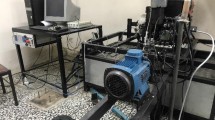Abstract
Controlled atomization is essential for reducing soot emission in practical diesel engines. In this work, an auxiliary device called a FAD (fuel activation device) was inserted into the fuel injection line to induce cavitation in the diesel spray. The performance of the FAD was examined in terms of pollutant emissions in a field test as well as aerosol sizes in lab-scale experiments. Experimental results showed that FAD reduced the size distribution of injected droplets and decreased the fuel consumption rate and emission amounts of PM10, CO, and NOx by 42%, 50% and 13.4%, respectively.
Similar content being viewed by others
References
N. Kumar and S. R. Chauhan, J. Renew. Sustain. Energy Rev., 21, 633 (2013).
J. M. Bergthorson and M. J. Thomson, J. Renew. Sustain. Energy Rev., 42, 1393 (2015).
N. Yilmaz, Fuel, 94, 444 (2012).
W. Kim, The Seoul Institute Annual Research Digest 2016, The Seoul Institute, Seoul (2016).
S. Gupta, R. Poola and R. Sekar, SAE Trans., 109, 1713 (2000).
M. Talibi, P. Hellier, R. Balachandran and N. Ladommatos, Int. J. Hydrogen Energy, 39, 15088 (2014).
J. Heywood, Internal combustion engine fundamentals, McGraw-Hill, New York (1988).
F. Xing, A. Kumar, Y. Huang, S. N. Chan, C. Ruan, S. Gu and X. L. Fan, Appl. Energy, 193, 28 (2017).
L. P. Bayvel, Liquid atomization, Taylor & Francis, Washington, D.C. (1993).
S. Sharma, R. Kumar, A. Chowdhury, Y. Yoon and S. Kumar, Fuel, 199, 229 (2017).
W. Bergwerk, Proc. Inst. Mech. Eng., 173, 655 (1959).
J. Benajes, J. V. Pastor, R. Payri and A. H. Plazas, J. Fluids Eng., 126, 63 (2004).
R. Payri, J. M. Garcia, F. J. Salvador and J. Gimeno, Fuel, 84, 551 (2005).
H. K. Suh, S. W. Park and C. S. Lee, Fuel, 86, 2833 (2008).
C. E. Brennen, Cavitation and Bubble Dynamics, Oxford University Press, New York (1995).
W. H. Nurick, J. Fluids Eng., 98, 681 (1976).
A. Sou, M. I. Maulana, K. Isozaki and A. Tomiyama, J. Fluid Sci. Technol., 3, 622 (2008).
N. Tamaki, M. Shimizu, K. Nishida and H. Hiroyasu, Atomization Sprays, 8, 179 (1998).
C. Soteriou, R. Andrews and M. Smith, SAE Trans., 104, 128 (1995).
S. I. Choi, J. P. Feng, H. S. Seo and Y. M. Jo, J. Korean Soc. Atmos. Environ., 33, 306 (2017).
C. Arcoumanis, H. Flora, M. Gavaises and M. Badami, SAE Trans., 109, 1485 (2000).
G. J. Jiang, Y. S. Zhang, H. Wen and G. Xiao, Energy Convers. Manage., 103, 208 (2015).
Y. Q. Gao, M. R. Wei, F. W. Yan, L. F. Chen, G. Z. Li and L. Y. Feng, Exp. Therm. Fluid Sci., 87, 69 (2017).
Z. X. He, Z. Y. Zhang, G. M. Guo, Q. Wang, X. Y. Leng and S. X. Sun, Int. J. Heat Mass Transf., 78, 13 (2016).
B. Carsten, Mixture Formation in Internal Combustion Engine, Springer Publications, New York and Berlin (2006).
L. L. Moyne, Int. J. Spray Combust., 2, 49 (2010).
F. J. Salvador, S. Ruiz, M. Crialesi-Esposito and I. Blanquer, Int. J. Multiph. Flow, 102, 49 (2018).
M. Arai, Physics behind diesel sprays and its combustion, LAP Lambert Academic Publishing (2016).
M. Gavaises, A. Andriotis, D. Papoulias, N. Mitroglou and A. Theodorakakos, Phys. Fluids, 21, 052107 (2009).
Z. X. He, W. J. Zhong, Q. Wang, Z. C. Jiang and Z. Shao, Int. J. Therm. Sci., 70, 132 (2013).
A. Sou, B. Biçer and A. Tomiyama, Comput. Fluids, 103, 42 (2014).
Z. X. He, X. C. Tao, W. J. Zhong, X. Y. Leng, Q. Wang and P. Zhao, Int. J. Heat Mass Transf., 65, 117 (2015).
B. Bicer and A. Sou, Appl. Math. Model., 40, 4712 (2016).
B. Mohan, W. M. Yang and S. K. Chou, Eng. Appl. Comp. Fluid, 8, 70 (2014).
D. Park, T. Lee, Y. Lee, W. Jeong, S. B. Kwon, D. Kim and K. Lee, Sci. Total Environ., 575, 97 (2017).
B. S. Prabhakar, S. P. Laxmanrao and K. J. A. M. Salim, Int. J. Innov. Res. Sci. Eng. Technol., 2, 6200 (2013).
Z. M. Wang, H. M. Xu, C. Z. Jiang and M. L. Wyszynski, Fuel, 174, 140 (2016).
H. J. Kim, S. H. Park and C. S. Lee, Fuel Process. Technol., 91, 354 (2010).
D. L. Jing, F. Zhang, Y. F. Li, H. M. Xu and S. J. Shuai, Fuel, 199, 478 (2017).
G. B. Li, J. M. Cao, M. L. Li, Y. H. Quan and Z. Y. Chen, Fuel Process. Technol., 104, 352 (2012).
R. J. Schick, General guidelines on drop size measurement techniques and terminology, 47th Chemical Processing Industry Exposition, New York (1997).
H. Hiroyasu, T. Kadota and M. Arai, Bull. JSME, 26, 569 (1983).
G. M. Hidy, J. Colloid Sci., 20, 123 (1965).
A. Afshar, Evaluation of liquid fuel spray models for hybrid RANS/lLES and DLES prediction of turbulent reactive flows, University of Toronto, M.S. Thesis (2014).
H. K. Suh, S. H. Park and C. S. Lee, Int. J. Automot. Technol., 9, 217 (2008).
S. Lee and S. Park, Fuel, 137, 50 (2014).
S. Huang, P. Deng, R. H. Huang, Z. W. Wang, Y. J. Ma and H. Dai, Energy Convers. Manage., 106, 911 (2015).
H. Hiroyasu, Atomization Sprays, 10, 511 (2000).
K. K. Hendratna, O. Nishida, H. Fujita, W. Harano and D. H. Yoo, Int. J. Res. Rev. Appl. Sci., 5, 101 (2010).
İ. A. Reşitoĝlu, K. Altinişik, and A. Keskin, Clean Technol. Environ. Policy, 17, 15 (2015).
K. Azad, M. Rasul, B. Giannangelo and R. Islam, Int. J. Automot. Mech. Eng., 12, 2866 (2016).
Author information
Authors and Affiliations
Corresponding author
Rights and permissions
About this article
Cite this article
Feng, J.P., Choi, S.I., Seo, H.S. et al. Improvement of liquid fuel atomization for an internal engine using an auxiliary device. Korean J. Chem. Eng. 35, 2001–2009 (2018). https://doi.org/10.1007/s11814-018-0106-9
Received:
Accepted:
Published:
Issue Date:
DOI: https://doi.org/10.1007/s11814-018-0106-9




